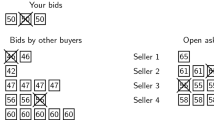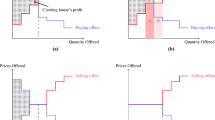Abstract.
We show that a profit maximizing monopolistic intermediary may behave approximately like a Walrasian auctioneer by setting bid and ask prices nearly equal to Walrasian equilibrium prices. In our model agents choose to trade either through the intermediary or privately. Buyers (sellers) trading through the intermediary potentially trade immediately at the ask (bid) price, but sacrifice the spread as gains. A buyer or seller who trades privately shares all the gains to trade with this trading partner, but risks costly delay in finding a partner. We show that as the cost of delay vanishes, the equilibrium bid and ask prices converge to the Walrasian equilibrium prices.
Similar content being viewed by others
Author information
Authors and Affiliations
Additional information
Received: 2 February 1996 / Accepted: 28 March 1997
Rights and permissions
About this article
Cite this article
Wooders, J. Equilibrium in a market with intermediation is Walrasian. Rev Econ Design 3, 75–89 (1997). https://doi.org/10.1007/s100580050006
Issue Date:
DOI: https://doi.org/10.1007/s100580050006




